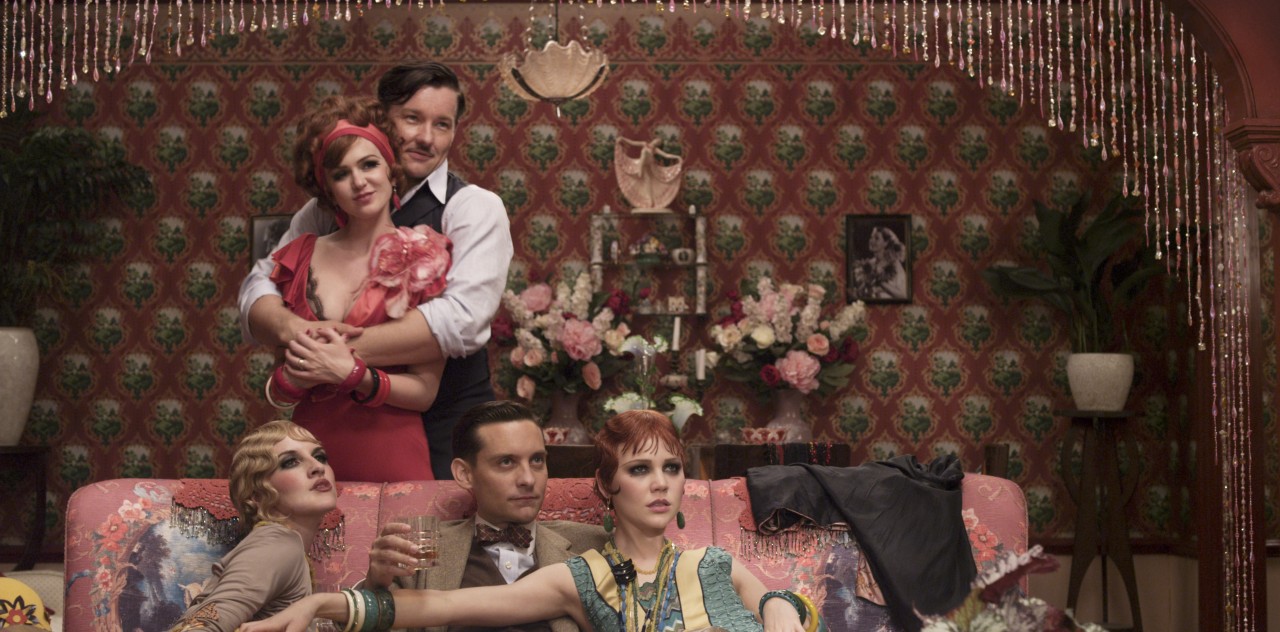

Myrtle (Isla Fisher), Tom (Joel Edgerton), Mrs. McKee (Kate Mulvany), Nick (Tobey Maguire) and Catherine (Adelaide Clemens) pose for Mr. McKee, The Great Gatsby (2013). Courtesy Warner Brothers
Much is being asked, this week, of how "true" or "faithful" to F. Scott Fitzgerald's novel The Great Gatsby Baz Luhrmann's movie is. These words of passionate fidelity are somewhat misplaced, always, when speaking of translating any artistic work from one medium to another. Anachronistic moments in the movie have gotten far more attention: use of contemporary music; a Duesenberg instead of a Rolls-Royce; Rhapsody in Blue premiering in 1924, and not 1922; Gatsby's father and the funeral not appearing in the end. However, the movie is not about re-creating the novel, nor about re-creating the summer of 1922. Here are a few more of my favorite movie moments that take something essential about the novel, and put them into cinematic terms (part two of three. Please read the post in full at my website).
1) Billowing curtains. The first time we see, through Nick Carraway's eyes, his distant cousin Daisy Buchanan in the novel, she's lying on a divan with Jordan Baker, and it's a magnificent moment as Fitzgerald's language floods you with description:
A breeze blew through the room, blew the curtains in at one end and out at the other like pale flags, twisting them up toward the frosted wedding-cake of the ceiling, and then rippled over the wine-colored rug, making a shadow on it as wind does on the sea. The only completely stationary object in the room was an enormous couch on which two young women were buoyed up as though upon an anchored balloon. They were both in white, and their dresses were rippling and fluttering as if they had just been blown back in after a short flight around the house.
This is exactly what happens in the movie. Catherine Martin's set follows Fitzgerald's lavish description to the letter, as Daisy (Carey Mulligan) and Jordan (Elizabeth Debicki) slowly materialize before Nick's (Tobey Maguire) charmed eyes amidst dozens of billowing sheer white curtains. Daisy's little hand, weighted down with Tom Buchanan's enormous diamond, twists itself up and over the back of the divan and reaches out for Nick before she delivers her first line (in the movie, and the book): "I'm p-paralyzed with happiness." (That Mulligan then flips Maguire over the sofa to land on his back on the floor shows a remarkable energy on her part that would, I think, rather mystify Fitzgerald.)
2) George Wilson as faintly handsome. That's Fitzgerald's first description of Wilson in the book: "a blond, spiritless man, anaemic, and faintly handsome." He has faded blue eyes like those of his "god," Dr. T. J. Eckleburg, and he wears a dark suit as he goes about his work at his garage. In the movie, he's hardly the "worn-out" man of the novel. Jason Clarke, as Wilson, tries to act downtrodden but also channels a bit of the young Marlon Brando in his work pants and undershirt. He gets the faintly handsome part spot on, and also, in the movie, he's risen to Myrtle's shouted challenge that constitutes her last line in the book: "Throw me down and best me, you dirty little coward!" Isla Fisher, as Myrtle, has a bloodied face when she hits back and runs from Wilson in the movie. He's a better looking, stronger, and more vital character in the movie -- a man of action, unfortunately, as we find out in the end.
3) The dog. The poor little dog Tom buys for Myrtle in New York from "a gray old man who bore an absurd resemblance to John D. Rockefeller" is, for my money, the most pathetic animal in literature. He, or she, is sadder even than the first animals whose fates made me cry in a novel: the puppies Hareton Earnshaw hangs from the back of a chair in Wuthering Heights. Police dog or Airedale, boy or girl, we don't know -- all we know is that the dog suffers terribly that afternoon and evening, and is never seen again after Chapter II. Late at night in Tom and Myrtle's apartment, we see that puppy for the last time surrounded by drunk, uncaring people: "The little dog was sitting on the table looking with blind eyes through the smoke, and from time to time groaning faintly." Only the dog's leash recurs, as something to make George Wilson suspicious and to depress Tom Buchanan, as the novel ends. I'm happy to say that the dog in the movie is a genial scene-stealer. Myrtle buys him in the Valley of Ashes and brings him to town, and he is as cute a movie dog as you could wish for -- like Uggie in The Artist, though he looks more like Nick and Nora Charles's Asta. He eats his dog biscuits and laps his saucer of milk with gusto, and talks a lot: whining in a concern that mirrors Nick's when Tom and Myrtle are noisily making love next door; barking assertively as the party gets wilder. He doesn't appear again, but somehow I feel the little guy in the movie is a survivor, unlike the dog in the novel.
4) Mr. McKee's lather spot. A memorable moment in Nick's drunken afternoon and evening with Tom and Myrtle in New York is Chester McKee. Mr. McKee, the downstairs neighbor, is a "pale, feminine man" who is "most respectful in his greeting to everyone in the room" as he arrives with his "shrill, languid, handsome, and horrible" wife. What does he do? He's "in the 'artistic game,'" a photographer, and the evening shaves off, in the novel, into an intoxicated ellipsis in which McKee is sitting in bed in his underwear showing Nick some of his pictures: "'Beauty and the Beast... Loneliness... Old Grocery Horse... Brook'n Bridge...'" The Nick-is-gay readings of Gatsby largely spring from this scene with McKee; I don't agree. What I do think is that McKee, like Nick, is an observer with an eye for art. It's terribly reductive, at the least, to say this must mean a man is gay. Yet McKee is described as feminine, and he does try to touch that elevator lever (which you have to admit might just be a funny moment. Sometimes writers make jokes, at the expense of drunken and prudish narrators like our Nick, and it's all right to laugh at them). In the movie, McKee is riotously played by Eden Falk, with eyeliner and a pencil-thin mustache, a lurid silk smoking jacket, and flamboyance from his exaggerated facial gestures to his flinging arms and legs and constantly snapping camera. Said Falk in an interview, "My character is a wannabe artist, one of those people that think he is a little bit better than he is in the 1920s art scene of New York. He is very foppish." He also has that spot of lather on one cheekbone that no one mentions, or no one notices, except for Nick. Late at night, McKee finally passes out, sitting upright in a chair. Nick springs into action: "Taking out my handkerchief I wiped from his cheek the remains of the spot of dried lather that had worried me all afternoon." I was happy to hear so many people laughing around me in Avery Fisher Hall, on the night of Gatsby's New York premiere, as Tobey Maguire wiped that lather spot away.
5) Ready for your close-up. No, this isn't a line from The Great Gatsby. However, it's in the movie. When Daisy and Jay meet again at Nick's, and then spend the afternoon at Gatsby's, Nick literally follows them with a camera. Unlike Chester McKee, Nick's using the camera less for artistic purposes than to make the point of his being a voyeur, here - it's a literalization of him watching Jay and Daisy interact that day, and telling us all about it. As Leonardo DiCaprio and Carey Mulligan cavort on Gatsby's beach, breaking golf clubs and swimming and laughing excessively, Maguire photographs, and films, them. At one point, as DiCaprio stands behind Mulligan with his arms around her, Maguire grins and, gazing down into the camera, asks, "Are you ready for your close-up?" Immediately you add, in your head, "Mr. DeMille." I was surprised that Luhrmann borrowed that classic line from Sunset Boulevard (1950), and put it into Nick's mouth, until I thought about the whole sweep of that movie. A Hollywood-epic love story gone hideously wrong; a silent star of the 1920s who kills a man in madness; William Holden narrating the movie from his singular perspective of being a body, shot, floating in a swimming pool. The Gatsby notes in Sunset Boulevard I had never thought of before Luhrmann's movie made me do so -- and there are very many. Billy Wilder and Charles Brackett, two men who knew and admired Fitzgerald, wrote Sunset Boulevard, and for their evocation of Norma Desmond and the Jazz Age she still inhabits clearly modeled much on Fitzgerald's stories and novels of the 20s. Luhrmann's use of the famous line in his movie is an educated homage.
To be continued.....
All quotations from the novel are from F. Scott Fitzgerald, The Great Gatsby (Scribners, 1925).
